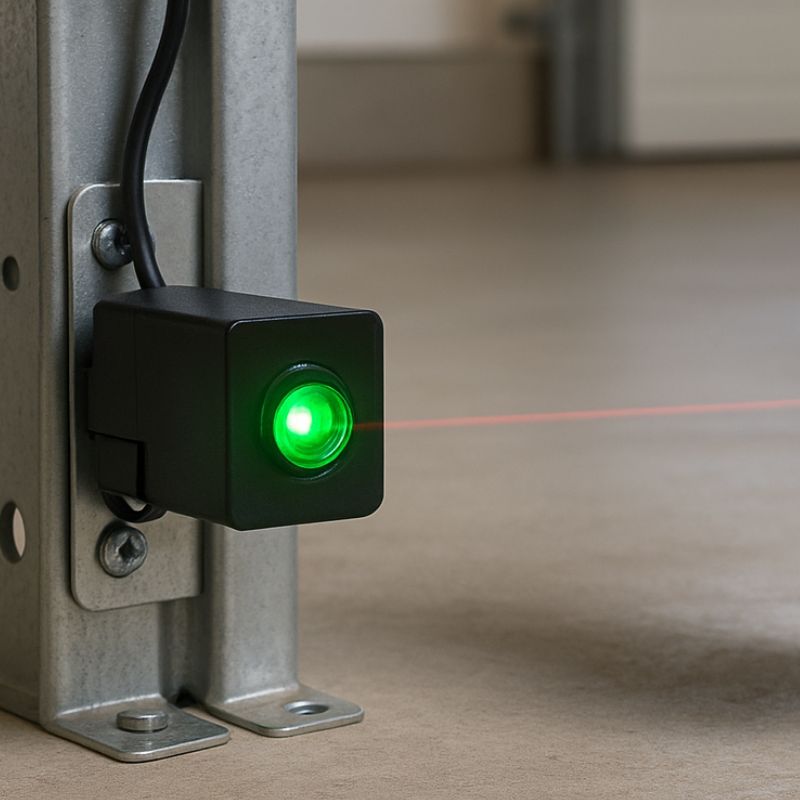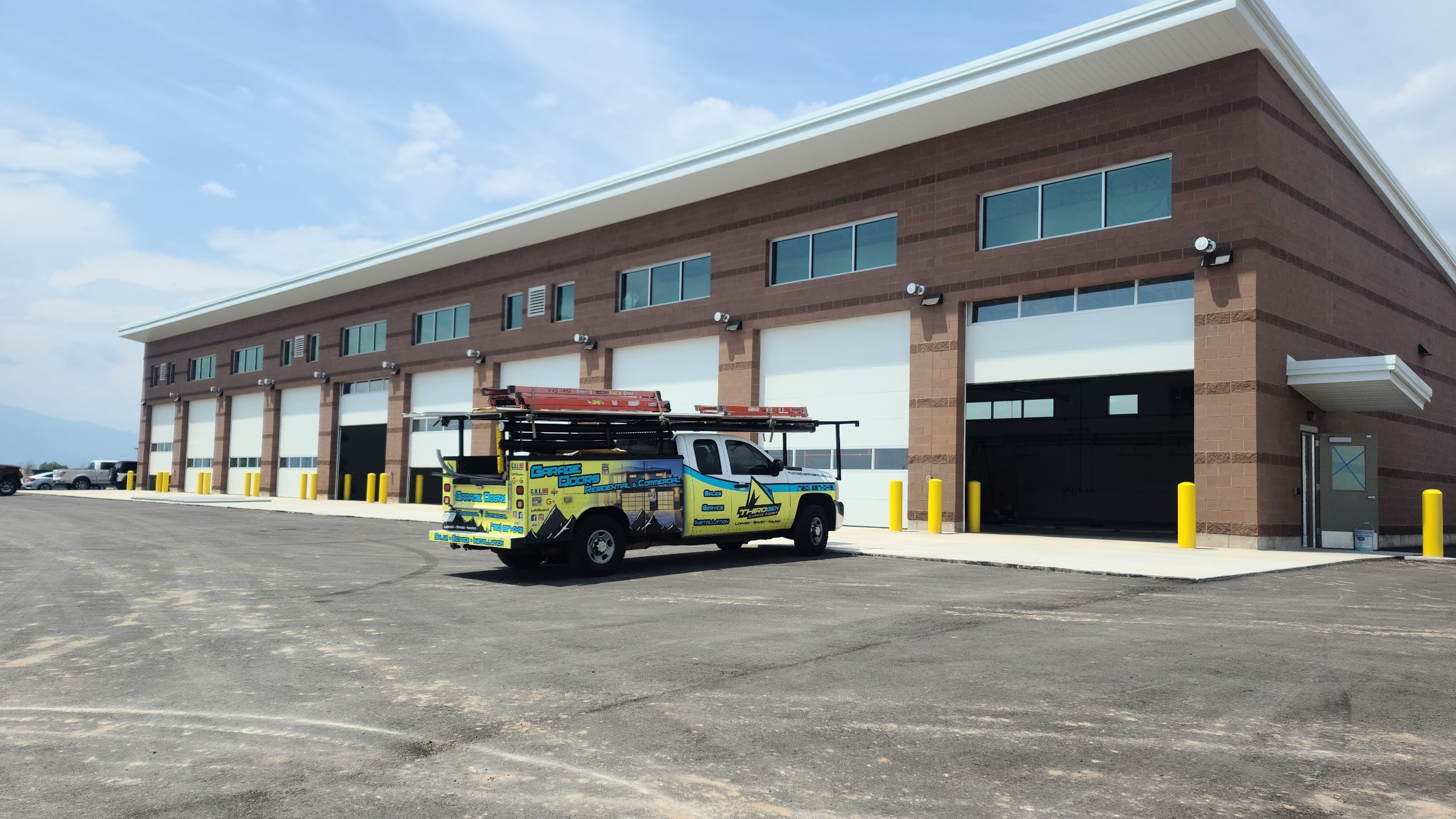Understanding Garage Door Safety Sensors: How They Work and Why They Fail
Garage door safety sensors might be small, but they do some of the most important work in your entire garage. These two little devices can prevent accidents, stop damage before it happens, and protect kids, pets, and anything else that might wander under the door at the wrong moment.
When they fail, the entire system stops working as designed. Suddenly the door will not close, lights start blinking, and your remote becomes about as useful as a paperweight.
If your garage door is refusing to close or keeps reversing for no obvious reason, you are likely dealing with a safety sensor problem. The good news is that these issues are common, often easy to diagnose, and usually straightforward for a professional to repair.
Below we break down everything homeowners in Colorado should know about how garage door sensors work, why they fail, and what to do when yours start acting up.
What Garage Door Safety Sensors Actually Do
Safety sensors were introduced as part of federal safety regulations in the 1990s. Every modern garage door opener includes them, and for good reason. Their primary job is simple. They prevent the garage door from closing on people, pets, or objects.
Most systems use infrared technology. One sensor (the sender) emits an invisible infrared beam across the bottom of the garage opening. The other sensor (the receiver) sits on the opposite side of the door’s track and waits to pick up that beam.
If the receiver sees a clear signal with no interruptions, the opener is allowed to close the door. If the beam is blocked, even slightly, the system stops or reverses immediately.
This basic safety feature has prevented countless injuries, which is why any issue with the sensors immediately disables the ability to close the door using the remote or keypad.
How Garage Door Safety Sensors Work Step-by-Step
To understand how easily sensor issues occur, it helps to know the simple process they follow each time you hit the close button.
- The sending sensor emits a steady infrared beam.
- The receiving sensor detects the beam.
- The garage door opener checks that the signal is clean and aligned.
- If everything looks good, the opener lowers the door.
- If the beam is interrupted, misaligned, weak, or inconsistent, the opener stops the door and reverses it for safety.
This sequence repeats every time the door closes. Even a slight misalignment or a bit of debris on the lens can disrupt the beam.

Common Signs Your Garage Door Sensors Are Not Working
Many homeowners call a repair company thinking the opener has failed when the real culprit is the sensors. Here are the most common warning signs:
- The garage door opens but will not close
- The door starts to close, then immediately reverses
- One or both sensor lights are off or blinking
- The opener light blinks several times when you try to close the door
- The door only closes if you hold down the wall button
- The sensors appear crooked, loose, or knocked out of position
- The area around the sensors is wet, icy, or covered in debris
If you are experiencing any of these issues, the sensors are the first place to look.
Why Garage Door Sensors Fail: The Most Common Causes
Sensor issues make up a huge percentage of garage door service calls. Fortunately, most failures trace back to just a few common causes.
Sensor Misalignment
This is by far the most frequent reason garage doors stop closing. If the sensors get bumped, nudged, kicked, bumped with a broom, hit with a bike tire, or lightly breathed on the wrong way, they can fall out of alignment. Even a few millimeters can cause the beam to miss its target.
Dirty or Blocked Lenses
Colorado garages see a lot of dust, wind, snow, and general debris. Anything covering the sensor lenses can disrupt the beam. Spider webs, leaves, grass clippings, pet hair, and even paint overspray have been known to cause problems.
Sunlight Interference
Because Colorado’s sunlight can be intense, direct sun hitting the receiving sensor can overpower the infrared beam. When this happens, the opener thinks the beam is missing and refuses to close the door.
Loose or Damaged Wiring
The wiring that runs from the opener down to the sensors can loosen over time or suffer damage from vibration, movement, pests, or moisture. A loose connection or partial break in the wire can cause inconsistent sensor signals.
Physical Damage to the Sensors
Lawn equipment, tools, kids’ toys, and car bumpers are all common reasons sensors end up broken. The casing is plastic, and it only takes one good hit to crack or misalign the device.

Moisture or Water Exposure
Snowmelt pooling near the base of the garage, heavy rain, or humidity can cause internal corrosion or shorting in the sensors. Sensors sit low to the ground, making them vulnerable to moisture.
Faulty Garage Door Opener Logic Board
It is rare, but sometimes the sensors are fine and the issue lies within the opener’s motherboard. If the logic board fails to read the sensor signal, the door will behave as if the sensors are not working.
Safe Troubleshooting Steps for Homeowners
Before calling a professional, there are some basic troubleshooting steps you can safely try. None of these involve tools, wiring, or anything risky.
1. Clean the Sensor Lenses
Use a soft cloth to gently remove dust or debris. Avoid using harsh cleaners that could cloud the plastic.
2. Remove Any Obstructions
Make sure no objects are in the path between sensors, even partially. A leaf can be enough to break the beam.
3. Check the Sensor Lights
Most sensors have LED indicators.
- Solid lights usually mean alignment is good
- Flashing lights usually mean misalignment
- No light means a power or wiring issue
4. Straighten and Realign Sensors
Make sure both sensors are mounted at the same height and pointing directly at each other. Tighten the wingnuts if they feel loose.
5. Inspect the Area for Sunlight Interference
If bright sunlight is hitting the receiver, try shading it temporarily. If the door works afterward, the issue may require a more permanent fix.
6. Check the Wiring for Visible Damage
If any wires appear frayed, chewed, loose, or worn, stop troubleshooting and call a professional immediately.
7. Test the Door Using the Wall Button
If the door only closes when you hold the wall button, the problem is almost always related to the sensors.
If you have tried these steps and the problem persists, the sensors may need repair, rewiring, or replacement.
When to Call a Professional
Some homeowners attempt DIY sensor repairs and quickly discover that small adjustments can become big headaches. It is time to call a professional when:
- The sensors will not light up at all
- The wiring is damaged or loose
- You suspect a logic board issue
- The sensors fail repeatedly after alignment
- The sensors have visible cracks or physical damage
- The issue began after a storm, power surge, or ice buildup
- You want a permanent fix for sunlight interference
Safety sensors are a critical part of your garage door system. If they are not working properly, the opener disables important safety features.
A professional can diagnose the problem quickly and ensure your system meets safety standards.
How Colorado Weather Affects Garage Door Sensors
Local climate plays a major role in how often garage door sensors fail. Colorado has several unique challenges that homeowners elsewhere do not deal with.
Intense Sunlight
High-altitude sunlight is extremely bright and can overpower infrared signals, especially during late afternoon hours.
Snow and Ice Buildup
Sensors sit low to the ground, right where snow accumulates. Snow piles, slush, and ice can block the beam or cause moisture damage.
Metal Expansion and Contraction
Temperature swings can shift door tracks or brackets slightly, throwing sensors out of alignment.
Rodent Activity
Mice and other small pests sometimes chew on low-hanging sensor wires. It is more common than homeowners realize.
High Winds
Wind vibration can shake bolts loose over time, misaligning sensors.
These environmental factors mean Colorado homeowners often experience sensor problems more frequently than those in milder climates.
How to Prevent Future Sensor Issues
Regular maintenance can dramatically reduce the number of sensor-related problems you experience.
- Keep the area around sensors clean and free from debris
- Gently wipe sensor lenses monthly
- Make sure the brackets stay tight
- Avoid storing items near the sensors
- Ensure snow and ice are cleared away from the base of the garage
- Schedule an annual garage door tune-up
- Replace damaged or aging wiring before it causes failures
- Install a sun shield if your sensors face direct afternoon sunlight
Most sensor problems start small and get worse with time. Prevention keeps your system reliable and reduces repair costs.
Final Thoughts
Garage door safety sensors are simple, effective, and essential for keeping your home and family safe. When they fail, your garage door system is designed to shut down closing operations until the issue is fixed.
That can be frustrating for homeowners, but it is also a powerful reminder of how important these sensors are.
If your garage door is reversing unexpectedly, refusing to close, or showing blinking sensor lights, our team at Third Gen Garage Doors can help.
We diagnose and repair safety sensor issues quickly and make sure your entire garage door system is safe, aligned, and working properly.
Need fast garage door sensor repair in Denver, Golden, or the surrounding area?
Contact Third Gen Garage Doors for same-day service.





